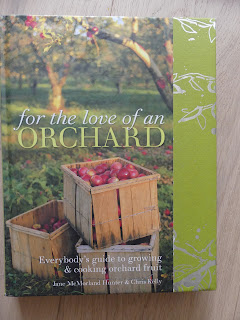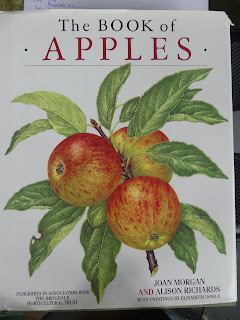I picked up the book below from the shelves in the village hall where we have the Keep Moving Group. They have all sorts of books in the entrance way shelving for people to buy, borrow or swap.
I think it's a book that I owned once and got rid of in one of the moves. I've donated several books in it's place.
It's not so long ago that supermarkets had very few varieties of apples for sale, and for several years Golden Delicious prevailed. Things are a bit better with usually more choice now. Yet there are several dozens named in another lovely book that I've had a while, that are never seen available to buy.
In this country 2000 years ago the apples growing were crab apples, impossible to eat raw but they would have been fermented or cooked. It was the Romans who brought their knowledge of grafting and pruning with them and used them to improve the native stock as well as bringing trees over from the continent. Italy was one huge orchard according to the poet Horace (65BC - 8BC). Fruit trees even had their own God - Pomona. The ancient custom of feasts for Samhain coincided with celebrations for the God Pomona ( and later both were taken over by Christianity as The Feast of All Souls and All Hallows Eve.)
Apples have so much folklore connected with them and magical reputation in many countries.
An Apple a day keeps the doctor away
A bloom on the tree when the apples are ripe, is a sure termination of somebody's life
Sun shining through the Apple Tree branches on Christmas day foretells a good crop
Orchards for cultivating fruit came here from the continent with monks and all monasteries would have had orchards of native fruits for eating and for making cider. Records of these have survived at Ely, Canterbury and Battle Abbey. There were substantial orchards at royal residences too. Later, farms would have had their own cider apple orchards as farmworkers were often paid in part with cider. After 1485 with the Tudors, things became more settled and orchards appeared more often in villages and towns with gentlemen gardeners in their country houses beginning to breed different varieties.
Here in my small garden I planted 3 Minarette Ⓡ apple trees. These grow straight upright and side branches are pruned with apples growing on these side spurs. This season was their third and only one, the Falstaff, had apples. This tree also had a few in it's first year of 2022 and they were so delicious that I bought a young ordinary tree which produced a few fruit this year - it's second year here. The other two Minarette are Charles Ross and didn't even flower this year, hopefully they will do better next year
Falstaff are a James Grieve X Golden Delicious, bred at the Institute of Horticulture, East Malling. Introduced in 1986 They are described as having a pretty red flush with stripes. Fruity, well balanced; crisp and juicy. Planted commercially small scale in Kent. Often heavy croppers .Picking - early October, will store until December.
I should have thinned the fruit early summer, I would have got less fruit but they would have been bigger so I'm having to eat two small for my 'apple a day' - something I've been doing for years - and I don't get many colds so maybe it works. Although it's probably more likely to be due to living alone and not spending too much time in crowded indoor situations. I've still got some 'Cold Cure' soup in the freezer just in case and as I've got some cider vinegar in the cupboard I'm planning to make some 'Fire Elixir' too.
Back Soon
Sue


It's Apple Day at our museum on Sunday - with the opportunity to try many older varieties. I miss the lovely James Grieve tree we had in our London garden 30 years ago. Beautiful fruit every year...
ReplyDeleteThey have some apple themed activities at the Food Museum in Stowmarket in half term but it's £15 to get in!
DeleteI enjoyed the history lesson - thank you. I grew up not far from East Malling.
ReplyDeleteSo much information in those two books and lovely drawings
DeleteSome fascinating apple facts there. Fire Elixir sounds interesting......
ReplyDeleteAlison in Wales x
In one book I have it's called Elixir No 9 but it has fresh turmeric and horseradish that I'm not going to find anywhere so mine won't have 9 ingredients. I'll write about it when I make it
DeleteFire Cider is an excellent remedy! Then apples are full of goodness so that helps. I think Oct 21 is National Apple Day.
ReplyDeleteThere's only one Apple Day locally and it's £15 to get in with mainly childrens activities!
DeleteApple Day here too this weekend, in the village Community Orchard - and it's free to get in. I'm looking forward to going (providing it's not chucking it down!).
ReplyDeleteNothing interesting happens for free here!
DeleteI don't think we have an apple day here but I do have the "apple a day" habit. My favourites are Gala and Granny Smith.
ReplyDeleteI’m off to an orchard with my daughter tomorrow. There is nothing like walking through one and picking apples.
ReplyDelete